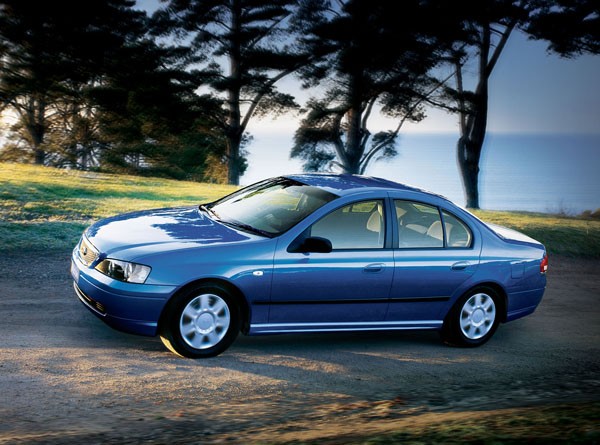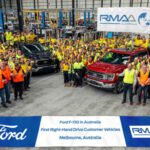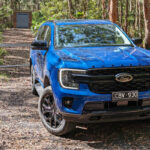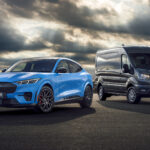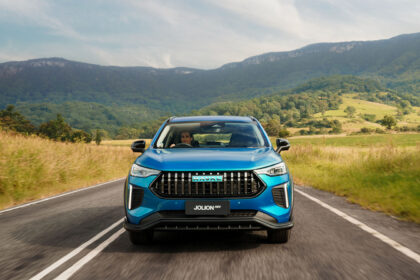Ford’s Falcon has slipped from the minds of many new-car buyers in recent years, resulting in the sad news that production will cease late in 2016.
However, the iconic Falcon has long been a favourite with used-car buyers and there’s no sign of that changing anytime soon.
To some extent we blame the demise of the Falcon on over adventurous styling. The radical shape of the AU was years ahead of its time when it was introduced in September 1998 and many conservative buyers didn’t like it. Facelifts to create the AU Falcon Series II in April 2000 and to the AU III in November 2001 lifted sales slightly. In September 2002 a major facelift to produce the BA Falcon started to put the Falcon back on track in new sales. The BA Falcon was upgraded to the BF Falcon in October 2005.
The introduction of the rather conservative FG-series Falcon saw sales slip again, and history shows that Ford Australia never did recover after that.
Falcons have seating for five adults, though four makes more sense because rear-wheel drive means the transmission tunnel takes up a lot of footroom in the centre-rear position. Legroom and headroom are ample for all but the largest adults. Some find the relatively steep slope of the roof in the AU to BF Falcons make it awkward to get in and out; naturally the back seat of the wagon doesn’t have this hassle.
Comfort is very good and passengers can step out of a Falcon after a trip of hundreds of kilometres still feeling fresh and relaxed.
The boot in the sedan is rather shallow in the older models and the slope of the bootlid on the AU reduces its practicality. It’s easy to load thanks to a good-sized opening. The BA Falcon is better, though still on the shallow side.
Falcon station wagons are great load carriers as they are built on a longer wheelbase than the sedan so they have a long, wide, practical cargo area. The rear end of the BA is virtually identical to that of the older AU. Ford chose not to do an FG variant of the wagon. Instead, it created a Series III BF model to sell alongside the FG sedans. It wasn’t a success and was discontinued in 2010.
Handling is surprisingly good for a car of this size and mass. You wouldn’t call it agile, but Falcons hold on when cornering at speeds far above those likely to be attempted by most drivers.
Ford’s six-cylinder engines all have a capacity of 4.0 litres but come in several formats, including one with a turbocharger. An interesting variant on the six-cylinder is a dedicated LPG engine. Very common in taxis, but less so in private cars (except in Victoria) this engine is all but indistinguishable from a petrol unit to drive. It’s quite a bit thirstier than the petrol so fuel range suffers.
The standard AU six-cylinder unit is good enough, but the BA’s six-cylinder is noticeably smoother and offers even better performance.
Ford fitted a 5.0-litre V8 to the AU, but it didn’t have a lot more performance than the six-cylinder units and was on the thirsty side. Much better were the BA bent eights: there was a choice of two, both with a capacity of 5.4 litres, one with a single-cam cylinder head, the other with a twin-cam setup.
A powerful four-cylinder engine, tagged the EcoBoost gave us arguably the best Falcon ever, thanks to excellent performance and nimble handling, the latter due to the lighter weight of the smaller engine. Buyers in this market segment can be on the conservative side and they stayed away from the EcoBoost in droves.
Automatics were all four-speed units until the launch of the BF, when a sophisticated six-speed ZF unit was installed. The ZF was originally only fitted in the topline variants, with the introduction of the FG Falcon all received the six-speed auto, with the exception of the LPG power models, which stuck with the old four-speed unit until the launch of the new-design LPG unit in July 2011.
Manual gearboxes are rare and probably best avoided in all but the sporting XR6 and XR8 as they can affect resale value. The manual was a five-speed until the BF series, when a six-speed was installed.
Prices for spare parts, servicing and repairs are very reasonable and there are Ford dealers just about everywhere in Australia. Most spare parts for the Falcons covered here are readily available, although a few bits on some older cars may have to come from a wrecker.
These are very simple cars to work on, with plenty of underbonnet and undercar space. We recommend having a workshop manual at your elbow before starting the work.
Insurance prices are generally very reasonable and premiums for the everyday models are invariably at the lower end of the scale. It will generally cost more to cover a V8 Falcon than a straight-six, and more expensive for a turbo six.
WHAT TO LOOK FOR
Rust is far less of a problem in these newer Falcons than old ones. To be on the safe side, check the door lower corners, door sill panels, mudguards and bootlid. If you do find serious rust the car may have been badly repaired after a crash.
Many thousands of used Falcons will have been taxis at some time in their life. Be wary of one running on dedicated LPG; while these are quite common in Victoria, they are rare anywhere else in Australia. Signs of an ex-taxi are vinyl, rather than cloth, upholstery, severe wear both inside and out, holes where signs and a taximeter have been removed, and possibly a paint respray.
Engine wear is indicated by a reluctance to start and by smoke from the exhaust and/or oil filler cap when the engine is revved.
Four-speed automatics can cause problems on hard-driven cars, especially the older models. Check they change gears cleanly and don’t hunt up and down through the ratios. Be suspicious of any automatic that’s slow at going into gear from Neutral or Park.
Listen for a whining differential when driving at around 60 to 90km/h.
Check the cabin for damage caused by wild kids. In station wagons have a good look at the load area for signs of commercial use
HOW MUCH?
Expect to pay from $4000 to $7000 for a 2003 Ford Falcon XT; $6000 to $10,000 for a 2004 Fairmont Ghia; $8000 to $12,000 for a 2008 Futura wagon; $12,000 to $17,000 for a 2008 Falcon XR6; $14,000 to $20,000 for a 2009 Falcon XR6; $21,000 to $29,000 for a 2011 Falcon XR6; $25,000 to $34,000 for a 2012 Falocn XR6 LPG; and $30,000 to $41,000 for a 2013 Falcon XRGT.
CAR BUYING TIP
Beware ex-taxis: they are run hard and often not driven in a sympathetic manner.





